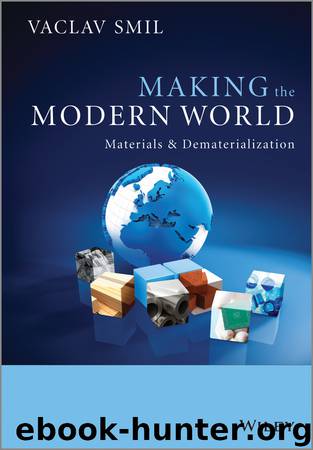Making the Modern World by Vaclav Smil

Author:Vaclav Smil
Language: eng
Format: epub
Publisher: John Wiley & Sons
Published: 2013-09-10T16:00:00+00:00
4.6 Life-Cycle Assessments
Quantifications of energies embedded in materials are useful and revealing companions to standard analyses of material flows using mass or value. But a brief reflection shows that even the combination of mass, value, and energy does not provide a sufficient basis for informed and balanced assessment because it leaves out the broad category of environmental impacts. Moreover, such assessments should not be limited to costs and impacts at the production stage, because many materials are parts of products and structures that will serve for years and decades and the full consequences of their use can be appreciated only by appraising their life-long trajectories. As the OECD put it, “all the phases of organized matter and energy that are in some way related to the making and use of a product can also be linked to an impact on the environment” (OECD, 1995).
The discipline that is doing precisely this – quantifying objective indicators of the environmental impacts of materials during their entire life-span – is life-cycle assessment (or life-cycle analysis, with the identical acronym, LCA), now a widely accepted procedure that has been codified as part of international environmental management standards that are routinely used to evaluate the various burdens imposed by production, use and disposal (or reuse) of products, and by the performance of services (ISO, 2006a,b). LCA is now a mature analytical discipline that has its own periodical, International Journal of Life Cycle Assessment, published since 1995, and an increasing number of how-to books (Horn et al., 2009; Jolliet et al., 2013), as well as extensive life-cycle inventory databases maintained by the US National Renewable Energy Laboratory (NREL, 2009; 2013a), by the European Commission (EC, 2009), and by the Swiss Centre for Life Cycle Inventories (Ecoinvent, 2013).
Varieties of LCA include complete cradle-to-grave sequences (from raw materials to final disposal) and partial cradle-to-gate assessments (that is for finished products before their distribution for sale). Inventory databases contain information on input and output flows for many materials, but a systematic look at the recently published LCAs (done in perhaps the most representative way by using appropriate searches of publications on the Web of Science) quickly reveals that the choice of assessed items (products or processes) has been guided neither by their importance to modern civilization (in that case studies of steel, concrete, and various plastics would dominate) nor by the quest to quantify the potentially most worrisome cases (in that case there would be many assessments of heavy metals). Instead, recently published life-cycle analyses offer a diverse choice: they are now available for a number of common crops; for foodstuffs including bread, milk, and tomatoes; for renewable energy production systems (biomass, wind, plant oils) and from tiny microchips and granite sidewalks to entire residential and office buildings.
Obviously, some of these findings will be fairly durable while other LCAs will require relatively frequent reassessments: making steel via the blast furnace-BOF-continuous casting route is not subject to the same rate of change as is the production of consumer electronics. LCA offers
Download
This site does not store any files on its server. We only index and link to content provided by other sites. Please contact the content providers to delete copyright contents if any and email us, we'll remove relevant links or contents immediately.
| Concrete | Extraction & Processing |
| Fracture Mechanics | Materials Science |
| Metallurgy | Polymers & Textiles |
| Strength of Materials | Testing |
Whiskies Galore by Ian Buxton(41931)
Introduction to Aircraft Design (Cambridge Aerospace Series) by John P. Fielding(33083)
Small Unmanned Fixed-wing Aircraft Design by Andrew J. Keane Andras Sobester James P. Scanlan & András Sóbester & James P. Scanlan(32760)
Craft Beer for the Homebrewer by Michael Agnew(18190)
Turbulence by E. J. Noyes(7972)
The Complete Stick Figure Physics Tutorials by Allen Sarah(7331)
Kaplan MCAT General Chemistry Review by Kaplan(6891)
The Thirst by Nesbo Jo(6870)
Bad Blood by John Carreyrou(6579)
Modelling of Convective Heat and Mass Transfer in Rotating Flows by Igor V. Shevchuk(6404)
Learning SQL by Alan Beaulieu(6232)
Weapons of Math Destruction by Cathy O'Neil(6201)
Man-made Catastrophes and Risk Information Concealment by Dmitry Chernov & Didier Sornette(5946)
Digital Minimalism by Cal Newport;(5695)
Life 3.0: Being Human in the Age of Artificial Intelligence by Tegmark Max(5503)
iGen by Jean M. Twenge(5382)
Secrets of Antigravity Propulsion: Tesla, UFOs, and Classified Aerospace Technology by Ph.D. Paul A. Laviolette(5328)
Design of Trajectory Optimization Approach for Space Maneuver Vehicle Skip Entry Problems by Runqi Chai & Al Savvaris & Antonios Tsourdos & Senchun Chai(5032)
Pale Blue Dot by Carl Sagan(4944)
